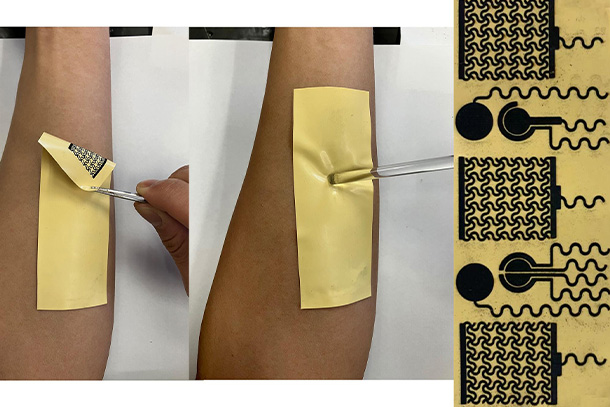
Penn State researchers recently developed an adhesive sensing device that seamlessly attaches to human skin to detect and monitor the wearer’s health. The writable sensors can be removed with tape, allowing new sensors to be patterned onto the device. Credit: Provided by Jia Zhu. All Rights Reserved.
Rewritable, recyclable ‘smart skin’ monitors biological signals on demand
May 30, 2024
Editor’s note: A version of this article was first published on Penn State News.
By Ashley WennersHerron
UNIVERSITY PARK, Pa. — Skin can send certain health-related signals, such as dry skin feeling tighter to indicate the need for moisture. But what if skin could be smarter, capable of monitoring and sharing specific health information, such as the concentration of glucose in sweat or heart rate? That was the question driving a team led by Penn State researchers that recently developed an adhesive sensing device that seamlessly attaches to human skin to detect and monitor the wearer’s health.
The details of the smart skin, including how it can be efficiently reprogrammed to detect various signals and even recycled, were published in Advanced Materials and featured on the cover of the journal's August issue. The paper was included in the “Rising Stars” series, which is coordinated by multiple journals to highlight work by early career researchers around the world. The researchers also filed a provisional patent application on the work.
“Despite significant efforts on wearable sensors for health monitoring, there haven’t been multifunctional skin-interfaced electronics with intrinsic adhesion on a single material platform prepared by low-cost, efficient fabrication methods,” said co-corresponding author Huanyu “Larry” Cheng, the James L. Henderson, Jr. Memorial Associate Professor of Engineering Science and Mechanics in the Penn State College of Engineering. “This work, however, introduces a skin-attachable, reprogrammable, multifunctional, adhesive device patch fabricated by simple and low-cost laser scribing.”
Cheng explained that conventional fabrication techniques for flexible electronics can be complicated and costly, especially as sensors built on flexible substrates, or foundational layers, are not necessarily flexible themselves. The sensor’s rigidity can limit the flexibility of the entire device. Cheng’s team previously developed biomarker sensors using laser-induced graphene (LIG), which involves using a laser to pattern 3D networks on a porous, flexible substrate. The interactions between the laser and the materials contained in the substrate produce conductive graphene.
“However, the LIG-based sensors and devices on flexible substrates are not intrinsically stretchable and can’t conform to interface with human skin for bio-sensing,” Cheng said, noting that human skin is changeable in shape, temperature and moisture levels, especially during physical exertion when monitoring heart rate, nerve performance or sweat glucose levels might be necessary. “Although LIG can be transferred to stretchable elastomers, the process can greatly reduce its quality.”
As a result, Cheng said, it’s more difficult to program a sensor device to monitor specific biological or electrophysical signals. Even when the device can be appropriately programmed, its sensing performance is often degraded.
“To address these challenges, it is highly desirable to prepare porous 3D LIG directly on the stretchable substrate,” said co-author Jia Zhu, who graduated with a doctorate in engineering science and mechanics from Penn State in 2020 and is now an associate professor at the University of Electronic Science and Technology of China.
The researchers achieved this goal by making an adhesive composite with molecules called polyimide powders that add strength and heat resistance and amine-based ethoxylated polyethylenimine — a type of polymer that can modify conductive materials — dispersed in a silicone elastomer, or rubber. The stretchable composite not only accommodates direct 3D LIG preparation, but also its adhesive nature means it can conform and stick to non-uniform, changeable shapes — like humans.
The researchers experimentally confirmed that the device can monitor the pH value, glucose and lactate concentrations in sweat as well as can be detected via finger prick blood draws. It can also be reprogrammed to monitor heart rate, nerve performance and sweat glucose concentrations in real time. Reprogramming is as simple as applying clear tape over the LIG networks and peeling them off. The substrate can then be re-lasered to new specifications, up to four times before it becomes too thin. Once it becomes too thin, the entire device can be recycled.
Critically, according to Cheng, the device remains adhesive and capable of monitoring even when the skin is made slick with sweat or water. Currently powered by batteries or near-field communication nodules, like a wireless charger, the device could potentially harvest energy and communicate over radio frequencies, which researchers said would result in a standalone, stretchable adhesive platform capable of sensing desired biomarkers and monitoring electrophysical signals. The team said they plan to work toward this goal, in collaboration with physicians, to eventually apply the platform to manage various diseases such as diabetes and monitor acute issues like infections or wounds.
“We would like to create the next generation of smart skin with integrated sensors for health monitoring — along with evaluating how various treatments impact health — and drug delivery modules for in-time treatment,” Cheng said.
Cheng is also affiliated with the Departments of Biomedical Engineering, of Mechanical Engineering, of Architectural Engineering and of Industrial and Manufacturing Engineering, as well as the Materials Research Institute and the Institute for Computational and Data Sciences. Other collaborators affiliated with the Department of Engineering Science and Mechanics at Penn State include Xianzhe Zhang, Chenghao Xing and Shangbin Liu, all graduate students; and Farnaz Lorestani, associate research fellow. Co-authors from outside of Penn State include Yang Xiao, Jiaying Li, Ke Meng, Min Gao, Taisong Pan and Yuan Lin, all with the University of Electronic Science and Technology of China; and Yao Tong, Yingying Zhang, Senhao Zhang, Benkun Bao and Hongbo Yang with the Suzhou Institute of Biomedical Engineering and Technology, Chinese Academy of Sciences. Li is also affiliated with the institute.
The U.S. National Institutes of Health, the U.S. National Science Foundation, Penn State, the University of Electronics Science and Technology China and the National Natural Science Foundation of China funded this research.

